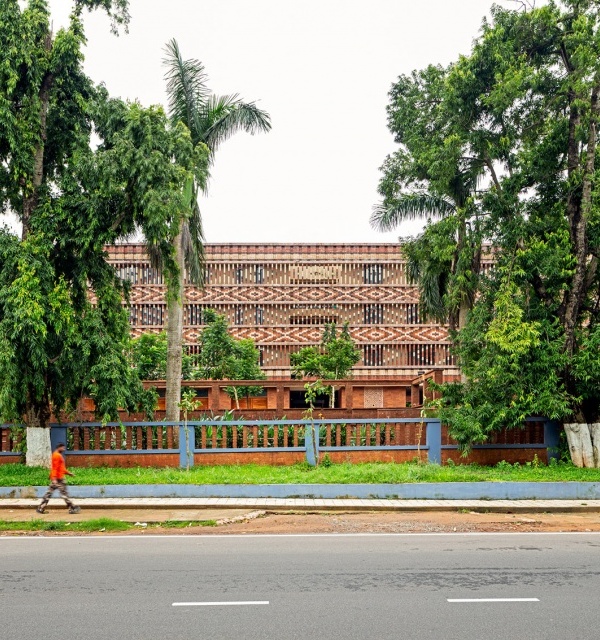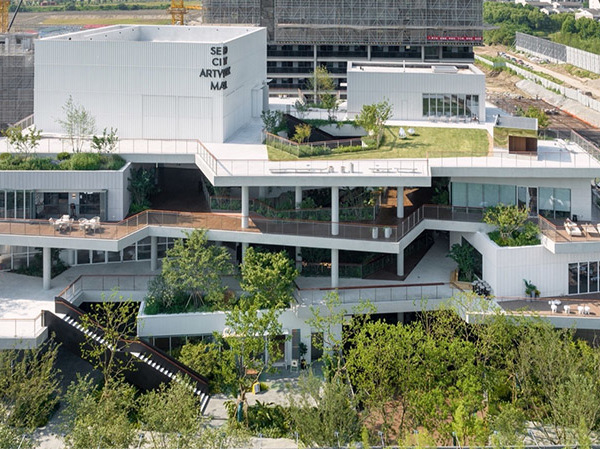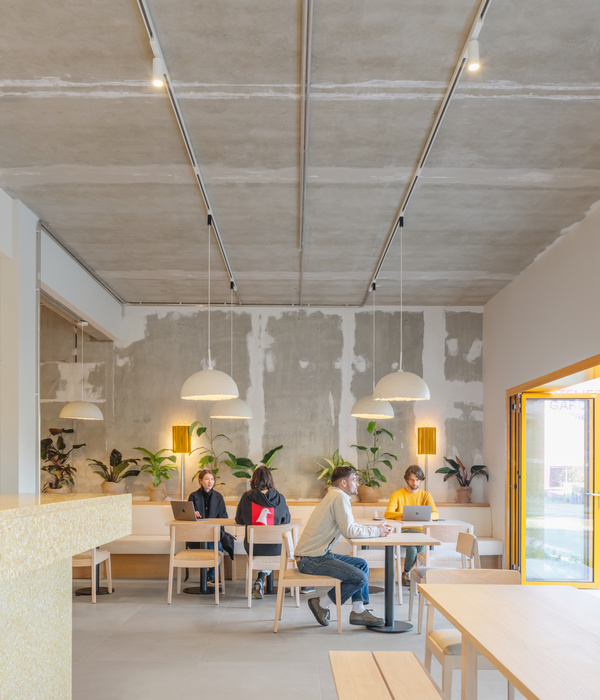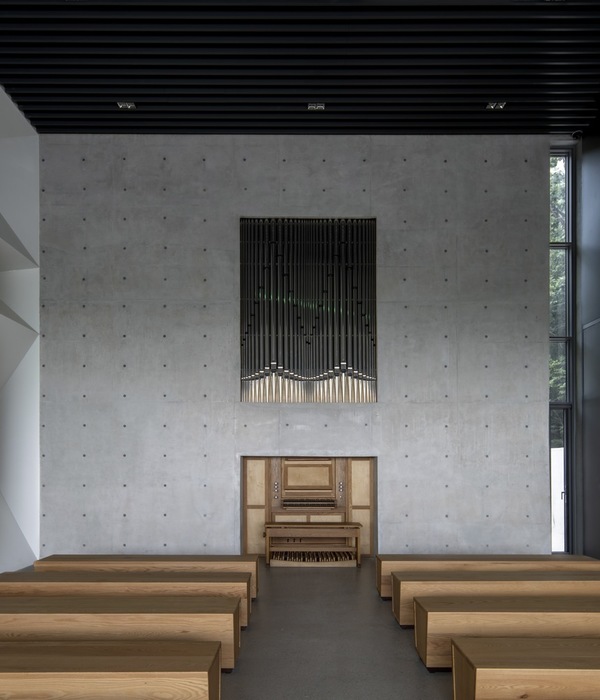- 项目名称:RISALITA AL MUSEO D’ARTE CONTEMPORANEA CASTELLO DI RIVOLI (TO)
- 设计师:Erich Hubmann & Andreas Vass,Architekten ZT
- 设计时间:2002-2004
- 建造时间:2007-2010
La Ronde: A New Path to the Castello di Rivoli on the Outskirts of Turin
The aim of the new circulation system at the Castello di Rivoli and the redesign of the southeast flank of the adjoining hillside is to create a closer link between the city and the castle. Rivoli, a small town on the western edge of Turin, is dominated by this monumental eighteenth-century Juvarra building, which was never completed. The castle, the culmination of a 13-kilometer-long baroque axis heading from the city to the countryside, sits atop a moraine. Castello di Rivoli currently houses an internationally renowned museum of contemporary art. The hill’s ridge is one of the city’s most important green spaces, while the largely unused areas surrounding the castle – particularly those on the southeast – hold potential for urban recreational space of the first order. The design seeks to use the outdoor spaces sustainably and link them more closely to the museum.
The prominent southeast slope of the hill, the site of the intervention, takes on a new key role. Across from the historic approach to the castle on the northwest side of the hill, facing away from the city, due to its location between the city’s “back” side and the incomplete garden wing of the castle (its monumental terraces were never realized), it remained inaccessible and undefined, an “inner periphery” – for centuries. The divergent scales of the city and the castle come together unmitigated in this interstitial space. This tension creates the setting for sustainable, not-for-profit uses, and can thus be manifest in a positive manner. The design lodges this inner periphery in the consciousness of the city’s residents and visitors on three different levels: as urban landscape with a new planting concept, as recreational space within walking distance, and, by means of the escalators and ramps incised in the hillside, as a direct connection. The small-scale building components in coloured concrete and Corten steel, as well as the surfaces wrought in Istrian limestone, gravel, and rammed earth emerge from the otherwise completely green hillside.
-Planting concept: By introducing plum, almond and mirabelle trees, the entire hillside is redefined as a third entity, an orchard situated between the city and the castle and making reference to the decaying fruit-growing at the foot of the Alpine crescent, whose location gave rise to the region’s name (Piemont = foot of the mountain), and which were the basis of the historic kingdom’s economy. At the same time, they constitute a counterweight to the intended display of power of the unrealized baroque gardens. -Paths and stopping points: The existing narrow streets, which served more to reroute traffic around the city centre than to provide access to the castle, have now been closed to automobile traffic and are the framework for the new system of paths. Embedded in the orchard, a truncated piece of an old street tied into the overall design via stairs and ramps serves as a place to pass time. A group of mature cedars shades a new system of stairs that is interspersed with terraces and flat segments of the path. -Access by escalator: On the side of the hill facing Turin, an intricate pattern of visual relationships is woven by the cuts in the slope and the traces of the spaces embedded within the slope, and dynamically frames the specific scales present in the surroundings – a smaller version of the system of axes in Turin’s landscape, between Venaria Reale, Stupinigi, Superga and Rivoli. The ascent and descent take different paths: via ramps, terraces, stairs and escalators, and through galleries, courtyards and grottoes, a relaxed, rhythmic sequence of movement, deemed La Ronde, provides surprising views of the buildings in Rivoli’s historic centre and Turin’s landscape.
At the crest of this succession of paths, a loggia – the only element which projects from the slope – marks the access to the castle’s new forecourt, which is to remain open and be used as a venue for public events following the next building phase. The remains of a medieval row of buildings that were destroyed to make way for a castle terrace were unearthed during the construction work. They shall be provided shelter and integrated in the design to bear testimony to the strained relationship between the city and the castle. Extensions to the project are planned for the future: panelling and cantilevering roofs will be inserted in the walls without openings accompanying the historic centre’s streets intersecting with the steep slope and a square on the edge of the historic centre will provide the connection to a future metro-line station.
Name of the project RISALITA AL MUSEO D’ARTE CONTEMPORANEA CASTELLO DI RIVOLI (TO) Short description The project reorganizes the connection between Castello di Rivoli and the small town at the border of the Turin plain. Escalators cut into the steep slopes of the hill are covered with a redefined fruit-tree landscape.
Location Rivoli (TO), Italy
Via Vittorio Amedeo / Via Mons.P.Borghezio (between Piazza Mafalda di Savoia, Piazza Marconi and Piazza Bollani)
Designer(s) Erich Hubmann & Andreas Vass, Architekten ZT (general project)
Period of design 2002-2004
Implementation period 2007-2010
Area ca. 2,5 acres / 10.000m2 (slope area)
Effective area –
Cost of construction (€) ca. 2,5 Mill.
Collaborators DI Johann Überlackner, Arqu. Luis Barbosa da Silva, Arch. Roland Fabiani, DI
Paul Stöffler
Structural engineering Gmeiner & Haferl, Ing.GesmbH, Wien Studio Linea, Padova
Hydraulic engeneering Studio Linea, Padova
Electric engineering Studio Linea, Padova (Ing. Laura Romito)
Landscape engineering Arch. Rosita Feltrin, Mestre
Photos model Werner Feiersinger
Photos project Werner Feiersinger, Michele d’Ottavio (Bird’s eye view),
Hubmann – Vass
Execution firms
General contractor S.I.E.G. S.p.A., Verdellino (BG)
Construction firm Costante&C. Costruzioni s.r.l., Rivoli (TO)
Building locksmith Ariotti s.r.l., Vercelli (VC)
Escalators, electric eng. S.I.E.G. S.p.A., Verdellino (BG)
Materials
walls, cantilever roofs: visible concrete (sand- / rust-coloured) escalator coverings: cor-ten steel pavements, steps, benches: istrian limestone roofs and furnishing elements: structural cor-ten steel
plantation: grassland, blackthorn, wild roses, fruit-trees (plum, almond, mirabelle, apricot, peach)
在都林西部的一个小镇上,有一座18世纪就修建的城堡。设计师设计了一条路径让山上的di Rivoli城堡和城市联系更加紧密。城堡里有着国际著名的当代博物馆,山坡上是城市重要的绿色景观。设计师挖掘场地的可持续性,在山坡上设计出一条有趣的室外空间路径。耐候钢板,彩色混凝土,以及小型建筑构件,碎石挡土墙穿梭在绿色的山间;坡道,楼梯,扶手电梯将路径串联,制造出不同的节奏感,让人领略城市的历史和惊人的美景。这里禁止车行,并引进了李树,杏树等植物,营造出一个类似巴洛克果园的概念绿化区。
设计时间2002—2004
建造时间2004—2010
MORE:
Hubmann Vass
,更多请至:
{{item.text_origin}}












